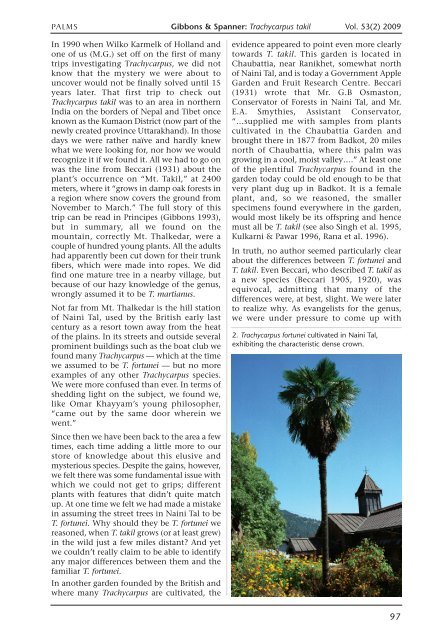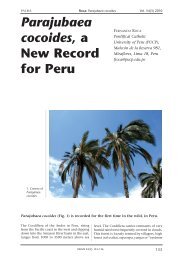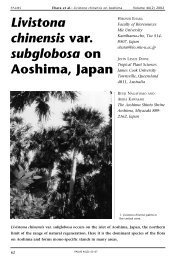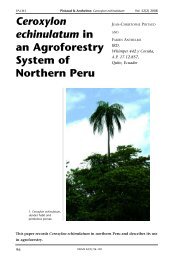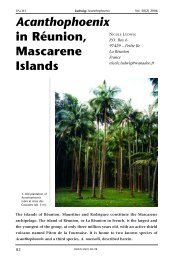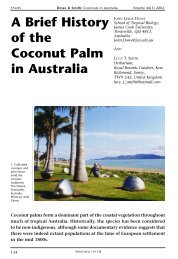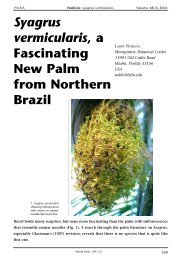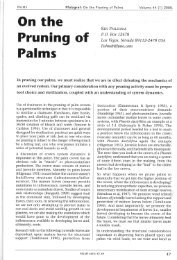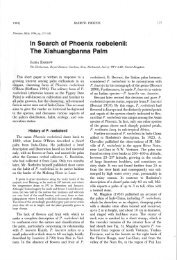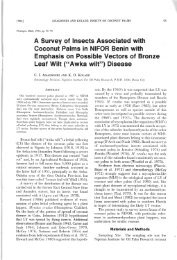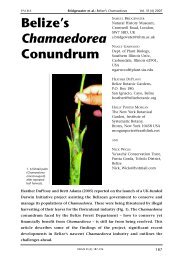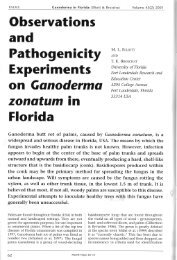Trachycarpus takil - International Palm Society
Trachycarpus takil - International Palm Society
Trachycarpus takil - International Palm Society
You also want an ePaper? Increase the reach of your titles
YUMPU automatically turns print PDFs into web optimized ePapers that Google loves.
PALMS Gibbons & Spanner: <strong>Trachycarpus</strong> <strong>takil</strong> Vol. 53(2) 2009<br />
In 1990 when Wilko Karmelk of Holland and<br />
one of us (M.G.) set off on the first of many<br />
trips investigating <strong>Trachycarpus</strong>, we did not<br />
know that the mystery we were about to<br />
uncover would not be finally solved until 15<br />
years later. That first trip to check out<br />
<strong>Trachycarpus</strong> <strong>takil</strong> was to an area in northern<br />
India on the borders of Nepal and Tibet once<br />
known as the Kumaon District (now part of the<br />
newly created province Uttarakhand). In those<br />
days we were rather naïve and hardly knew<br />
what we were looking for, nor how we would<br />
recognize it if we found it. All we had to go on<br />
was the line from Beccari (1931) about the<br />
plant’s occurrence on “Mt. Takil,” at 2400<br />
meters, where it “grows in damp oak forests in<br />
a region where snow covers the ground from<br />
November to March.” The full story of this<br />
trip can be read in Principes (Gibbons 1993),<br />
but in summary, all we found on the<br />
mountain, correctly Mt. Thalkedar, were a<br />
couple of hundred young plants. All the adults<br />
had apparently been cut down for their trunk<br />
fibers, which were made into ropes. We did<br />
find one mature tree in a nearby village, but<br />
because of our hazy knowledge of the genus,<br />
wrongly assumed it to be T. martianus.<br />
Not far from Mt. Thalkedar is the hill station<br />
of Naini Tal, used by the British early last<br />
century as a resort town away from the heat<br />
of the plains. In its streets and outside several<br />
prominent buildings such as the boat club we<br />
found many <strong>Trachycarpus</strong> — which at the time<br />
we assumed to be T. fortunei — but no more<br />
examples of any other <strong>Trachycarpus</strong> species.<br />
We were more confused than ever. In terms of<br />
shedding light on the subject, we found we,<br />
like Omar Khayyam’s young philosopher,<br />
“came out by the same door wherein we<br />
went.”<br />
Since then we have been back to the area a few<br />
times, each time adding a little more to our<br />
store of knowledge about this elusive and<br />
mysterious species. Despite the gains, however,<br />
we felt there was some fundamental issue with<br />
which we could not get to grips; different<br />
plants with features that didn’t quite match<br />
up. At one time we felt we had made a mistake<br />
in assuming the street trees in Naini Tal to be<br />
T. fortunei. Why should they be T. fortunei we<br />
reasoned, when T. <strong>takil</strong> grows (or at least grew)<br />
in the wild just a few miles distant? And yet<br />
we couldn’t really claim to be able to identify<br />
any major differences between them and the<br />
familiar T. fortunei.<br />
In another garden founded by the British and<br />
where many <strong>Trachycarpus</strong> are cultivated, the<br />
evidence appeared to point even more clearly<br />
towards T. <strong>takil</strong>. This garden is located in<br />
Chaubattia, near Ranikhet, somewhat north<br />
of Naini Tal, and is today a Government Apple<br />
Garden and Fruit Research Centre. Beccari<br />
(1931) wrote that Mr. G.B Osmaston,<br />
Conservator of Forests in Naini Tal, and Mr.<br />
E.A. Smythies, Assistant Conservator,<br />
“…supplied me with samples from plants<br />
cultivated in the Chaubattia Garden and<br />
brought there in 1877 from Badkot, 20 miles<br />
north of Chaubattia, where this palm was<br />
growing in a cool, moist valley….” At least one<br />
of the plentiful <strong>Trachycarpus</strong> found in the<br />
garden today could be old enough to be that<br />
very plant dug up in Badkot. It is a female<br />
plant, and, so we reasoned, the smaller<br />
specimens found everywhere in the garden,<br />
would most likely be its offspring and hence<br />
must all be T. <strong>takil</strong> (see also Singh et al. 1995,<br />
Kulkarni & Pawar 1996, Rana et al. 1996).<br />
In truth, no author seemed particularly clear<br />
about the differences between T. fortunei and<br />
T. <strong>takil</strong>. Even Beccari, who described T. <strong>takil</strong> as<br />
a new species (Beccari 1905, 1920), was<br />
equivocal, admitting that many of the<br />
differences were, at best, slight. We were later<br />
to realize why. As evangelists for the genus,<br />
we were under pressure to come up with<br />
2. <strong>Trachycarpus</strong> fortunei cultivated in Naini Tal,<br />
exhibiting the characteristic dense crown.<br />
97


